¶ Canon 5D Mark IV vs 80D
The Canon EOS 5D Mark IV and the Canon EOS 80D are two digital cameras that were officially introduced, respectively, in August 2016 and February 2016. Both are DSLR (Digital Single Lens Reflex) cameras that are based on a full frame (5D Mark IV) and an APS-C (80D) sensor. The 5D Mark IV has a resolution of 30.1 megapixels, whereas the 80D provides 24 MP.
Below is an overview of the main specs of the two cameras as a starting point for the comparison.
¶ Headline Specifications
 |
|
 |
| Canon 5D Mark IV | Canon 80D | |
| Digital single lens reflex | Digital single lens reflex | |
| Canon EF mount lenses | Canon EF mount lenses | |
| 30.1 MP, Full Frame Sensor | 24 MP, APS-C Sensor | |
| 4K/30p Video | 1080/60p Video | |
| ISO 100-32,000 (50 - 102,400) | ISO 100-16,000 (100 - 25,600) | |
| Optical viewfinder | Optical viewfinder | |
| 3.2 LCD, 1620k dots | 3.0 LCD, 1040k dots | |
| Fixed touchscreen | Swivel touchscreen | |
| 7 shutter flaps per second | 7 shutter flaps per second | |
| Weathersealed body | Weathersealed body | |
| 900 shots per battery charge | 960 shots per battery charge | |
| 151 x 116 x 76 mm, 890 g | 139 x 105 x 79 mm, 730 g |
Going beyond this snapshot of core features and characteristics, what are the differences between the Canon EOS 5D Mark IV and the Canon EOS 80D? Which one should you buy? Read on to find out how these two cameras compare with respect to their body size, their imaging sensors, their shooting features, their input-output connections, and their reception by expert reviewers.
¶ Body comparison
The side-by-side display below illustrates the physical size and weight of the Canon 5D Mark IV and the Canon 80D. The two cameras are presented according to their relative size. Three consecutive views from the front, the top, and the rear side are shown. All size dimensions are rounded to the nearest millimeter.
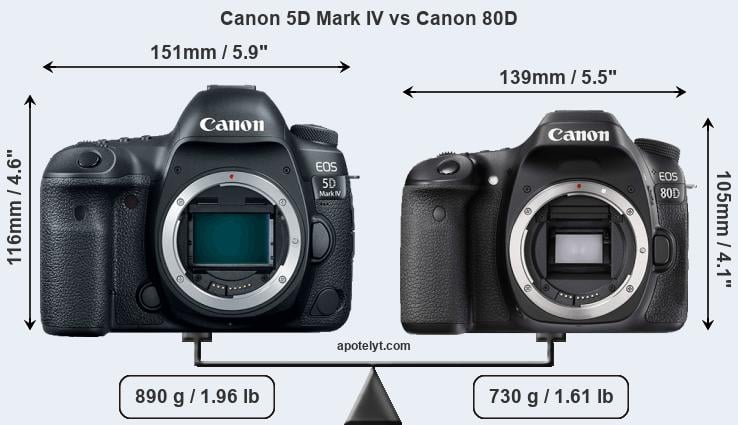

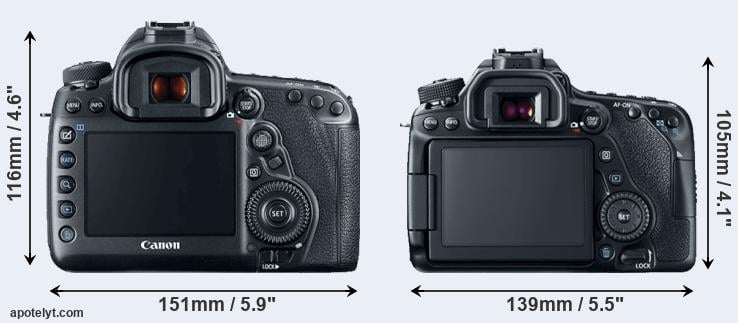
If the front view area (width x height) of the cameras is taken as an aggregate measure of their size, the Canon 80D is notably smaller (17 percent) than the Canon 5D Mark IV. Moreover, the 80D is markedly lighter (18 percent) than the 5D Mark IV. In this context, it is worth noting that both cameras are splash and dust-proof and can, hence, be used in inclement weather conditions or harsh environments.
The above size and weight comparisons are to some extent incomplete since they do not consider the interchangeable lenses that both of these cameras require. A larger imaging sensor (as in the 5D Mark IV) will tend to go along with bigger and heavier lenses, while more compact options are available for the smaller-sensor camera (80D). You can compare the optics available in the Canon EF Lens Catalog.
The adjacent table lists the principal physical characteristics of the two cameras alongside a wider set of alternatives. If you would like to visualize and compare a different camera combination, just use the right or left arrows in the table to switch to the respective camera. Alternatively, you can also navigate to the CAM-parator appand make your selection from the full list of cameras there.
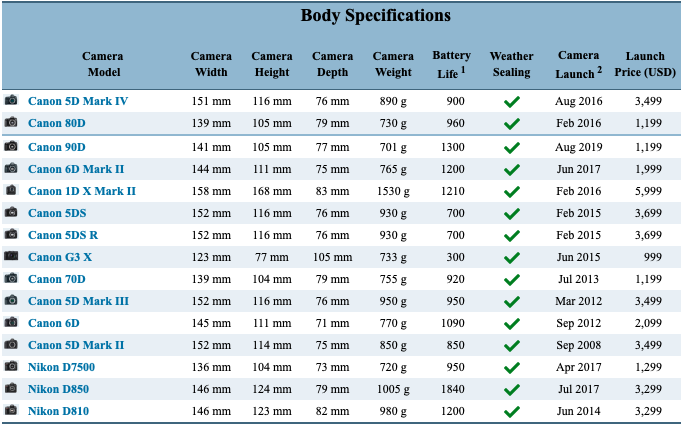
Any camera decision will obviously take relative prices into account. The listed launch prices provide an indication of the market segmentthat the manufacturer of the cameras have been targeting. The 80D was launched at a markedly lower price (by 66 percent) than the 5D Mark IV, which puts it into a different market segment. Usually, retail prices stay at first close to the launch price, but after several months, discounts become available. Later in the product cycle and, in particular, when the replacement model is about to appear, further discounting and stock clearance sales often push the camera price considerably down. Then, after the new model is out, very good deals can frequently be found on the pre-owned market.
¶ Sensor comparison
The imaging sensor is at the core of digital cameras and its size is one of the main determining factors of image quality. A large sensor will tend to have larger individual pixels that provide better low-light sensitivity, wider dynamic range, and richer color-depth than smaller pixel-units in a sensor of the same technological generation. Furthermore, a large sensor camera will give the photographer more possibilities to use shallow depth-of-field in order to isolate a subject from the background. On the downside, larger sensors tend to be more expensive and lead to bigger and heavier cameras and lenses.
Of the two cameras under consideration, the Canon 5D Mark IV features a full frame sensor and the Canon 80D an APS-C sensor. The sensor area in the 80D is 61 percent smaller. As a result of these sensor size differences, the cameras have a format factor of, respectively, 1.0 and 1.6. Both cameras have a native aspect ratio (sensor width to sensor height) of 3:2.
In terms of chip-set technology, the 5D Mark IV uses a more advanced image processing engine(DIGIC 6+) than the 80D (DIGIC 6), with benefits for noise reduction, color accuracy, and processing speed.

With 30.1MP, the 5D Mark IV offers a higher resolution than the 80D (24MP), but the 5D Mark IV nevertheless has larger individual pixels (pixel pitch of 5.36μm versus 3.75μm for the 80D) due to its larger sensor. Moreover, the 5D Mark IV is a somewhat more recent model (by 6 months) than the 80D, and its sensor might have benefitted from technological advances during this time that further enhance the light gathering capacity of its pixels.
The resolution advantage of the Canon 5D Mark IV implies greater flexibility for cropping images or the possibility to print larger pictures. The maximum print size of the 5D Mark IV for good quality output (200 dots per inch) amounts to 33.6 x 22.4 inches or 85.3 x 56.9 cm, for very good quality (250 dpi) 26.9 x 17.9 inches or 68.3 x 45.5 cm, and for excellent quality (300 dpi) 22.4 x 14.9 inches or 56.9 x 37.9 cm. The corresponding values for the Canon 80D are 30 x 20 inches or 76.2 x 50.8 cm for good quality, 24 x 16 inches or 61 x 40.6 cm for very good quality, and 20 x 13.3 inches or 50.8 x 33.9 cm for excellent quality prints.
The Canon EOS 5D Mark IV has a native sensitivity range from ISO 100 to ISO 32000, which can be extended to ISO 50-102400. The corresponding ISO settings for the Canon EOS 80D are ISO 100 to ISO 16000, with the possibility to increase the ISO range to 100-25600.
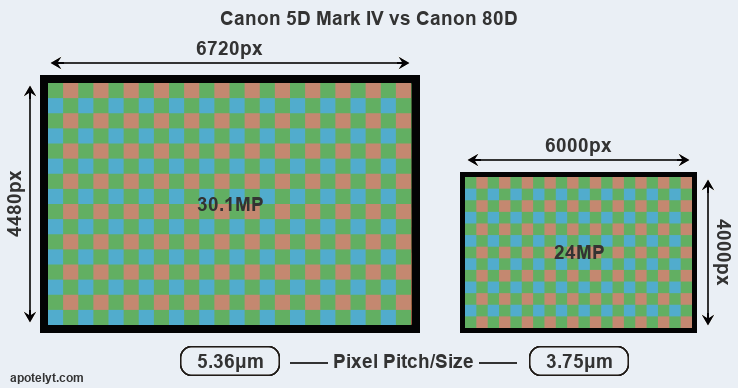
For many cameras, data on sensor performance has been reported by DXO Mark. This service determines an overall sensor rating, as well as sub-scores for low-light sensitivity ("DXO Sports"), dynamic range ("DXO Landscape"), and color depth ("DXO Portrait"). Of the two cameras under review, the 5D Mark IV provides substantially higher image quality than the 80D, with an overall score that is 12 points higher. This advantage is based on 1.2 bits higher color depth, 0.4 EV in additional dynamic range, and 1.4 stops in additional low light sensitivity. The table below summarizes the physical sensor characteristics and sensor quality findings and compares them across a set of similar cameras.
Sensor Characteristics
| Camera Model |
Sensor Class |
Resolution (MP) |
Horiz. Pixels |
Vert. Pixels |
Video Format |
DXO Portrait |
DXO Landscape |
DXO Sports |
DXO Overall |
|---|---|---|---|---|---|---|---|---|---|
| Canon 5D Mark IV | Full Frame | 30.1 | 6720 | 4480 | 4K/30p | 24.8 | 13.6 | 2995 | 91 |
| Canon 80D | APS-C | 24.0 | 6000 | 4000 | 1080/60p | 23.6 | 13.2 | 1135 | 79 |
| Canon 90D | APS-C | 32.3 | 6960 | 4640 | 4K/30p | .. | .. | .. | .. |
| Canon 6D Mark II | Full Frame | 26.0 | 6240 | 4160 | 1080/60p | 24.4 | 11.9 | 2862 | 85 |
| Canon 1D X Mark II | Full Frame | 20.0 | 5472 | 3648 | 4K/60p | 24.1 | 13.5 | 3207 | 88 |
| Canon 5DS | Full Frame | 50.3 | 8688 | 5792 | 1080/30p | 24.7 | 12.4 | 2381 | 87 |
| Canon 5DS R | Full Frame | 50.3 | 8688 | 5792 | 1080/30p | 24.6 | 12.4 | 2308 | 86 |
| Canon G3 X | 1-inch | 20.0 | 5472 | 3648 | 1080/60p | 21.4 | 12.3 | 521 | 63 |
| Canon 70D | APS-C | 20.0 | 5472 | 3648 | 1080/30p | 22.5 | 11.6 | 926 | 68 |
| Canon 5D Mark III | Full Frame | 22.1 | 5760 | 3840 | 1080/30p | 24.0 | 11.7 | 2293 | 81 |
| Canon 6D | Full Frame | 20.0 | 5472 | 3648 | 1080/30p | 23.8 | 12.1 | 2340 | 82 |
| Canon 5D Mark II | Full Frame | 21.0 | 5616 | 3744 | 1080/30p | 23.7 | 11.9 | 1815 | 79 |
| Nikon D7500 | APS-C | 20.7 | 5568 | 3712 | 4K/30p | 24.3 | 14.0 | 1483 | 86 |
| Nikon D850 | Full Frame | 45.4 | 8256 | 5504 | 4K/30p | 26.4 | 14.8 | 2660 | 100 |
| Nikon D810 | Full Frame | 36.2 | 7360 | 4912 | 1080/60p | 25.7 | 14.8 | 2853 | 97 |
Many modern cameras cannot only take still pictures, but also record videos. Both cameras under consideration have a sensor with sufficiently fast read-out times for moving pictures, but the 5D Mark IV provides a higher video resolution than the 80D. It can shoot video footage at 4K/30p, while the 80D is limited to 1080/60p.
¶ Feature comparison
Apart from body and sensor, cameras can and do differ across a range of features. The 5D Mark IV and the 80D are similar in the sense that both have an optical viewfinder. The latter is useful for getting a clear image for framing even in brightly lit environments. The viewfinders of both cameras offer the same field of view (100%), but the viewfinder of the 5D Mark IV has a higher magnification than the one of the 80D (0.71x vs 0.59x), so that the size of the image transmitted appears closer to the size seen with the naked human eye. The adjacent table lists some of the other core features of the Canon 5D Mark IV and Canon 80D along with similar information for a selection of comparators.
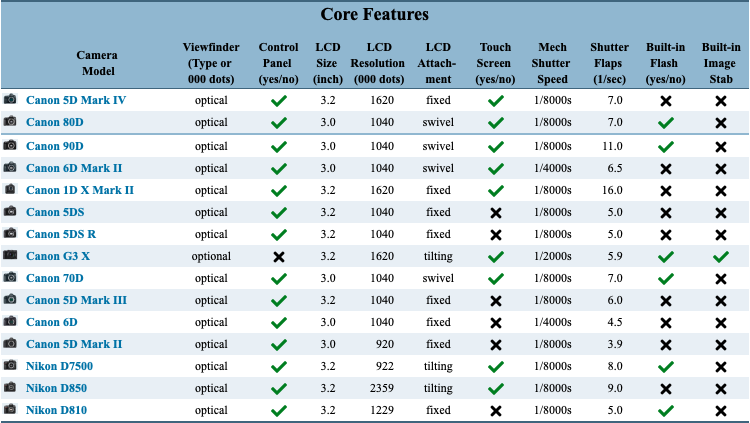
One difference between the cameras concerns the presence of an on-board flash. The 80D has one, while the 5D Mark IV does not. While the built-in flash of the 80D is not very powerful, it can at times be useful as a fill-in light.
The 80D has an articulated screen that can be turned to be front-facing. This characteristic will be appreciated by vloggers and photographers who are interested in taking selfies. In contrast, the 5D Mark IV does not have a selfie-screen.
The Canon 5D Mark IV and the Canon 80D both have an intervalometer built-in. This enables the photographer to capture time lapse sequences, such as flower blooming, a sunset or moon rise, without purchasing an external camera trigger and related software.
The 5D Mark IV writes its imaging data to Compact Flash or SDXC cards, while the 80D uses SDXC cards. The 5D Mark IV features dual card slots, which can be very useful in case a memory card fails. In contrast, the 80D only has one slot. Both cameras can use UHS-I cards, which provide for Ultra High Speed data transfer of up to 104 MB/s.
¶ Connectivity comparison
For some imaging applications, the extent to which a camera can communicate with its environment can be an important aspect in the camera decision process. The table below provides an overview of the connectivity of the Canon EOS 5D Mark IV and Canon EOS 80D and, in particular, the interfaces the cameras (and selected comparators) provide for accessory control and data transfer.
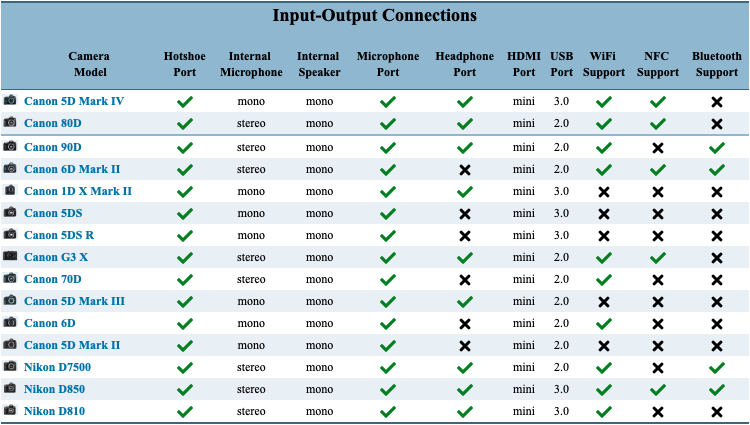
Studio photographers will appreciate that the Canon 5D Mark IV (unlike the 80D) features a PC Sync socket, so that professional strobe lights can be controlled by the camera.
Travel and landscape photographers will find it useful that the 5D Mark IV has an internal geolocalization sensor and can record GPS coordinates in its EXIF data.
The 5D Mark IV is a recent model that features in the current product line-up of Canon. In contrast, the 80D has been discontinued (but can be found pre-owned on eBay). As a replacement in the same line of cameras, the 80D was succeeded by the Canon 90D. Further information on the two cameras (e.g. user guides, manuals), as well as related accessories, can be found on the official Canon website.
¶ Review summary
So how do things add up? Is there a clear favorite between the Canon 5D Mark IV and the Canon 80D? Which camera is better? A synthesis of the relative strong points of each of the models is listed below.
¶ Advantages of the Canon EOS 5D Mark IV:
- More detail: Offers more megapixels (30.1 vs 24MP) with a 12% higher linear resolution.
- Better image quality: Scores substantially higher (12 points) in the DXO overall assessment.
- Richer colors: Generates images with noticeably better colors (1.2 bits more color depth).
- Better low-light sensitivity: Requires less light for good images (1.4 stops ISO advantage).
- Better jpgs: Has a more modern image processing engine (DIGIC 6+ vs DIGIC 6).
- Better video: Provides higher definition movie capture (4K/30p vs 1080/60p).
- Larger viewfinder image: Features a viewfinder with a higher magnification (0.71x vs 0.59x).
- Larger screen: Has a bigger rear LCD (3.2" vs 3.0") for image review and settings control.
- More detailed LCD: Has a higher resolution rear screen (1620k vs 1040k dots).
- Easier geotagging: Features an internal GPS sensor to log localization data.
- Faster data transfer: Supports a more advanced USB protocol (3.0 vs 2.0).
- Better studio light control: Has a PC Sync socket to connect to professional strobe lights.
- Greater peace of mind: Features a second card slot as a backup in case of memory card failure.
- More modern: Is somewhat more recent (announced 6 months after the 80D).
¶ Arguments in favor of the Canon EOS 80D:
- More flexible LCD: Has a swivel screen for odd-angle shots in portrait or landscape orientation.
- More selfie-friendly: Has an articulated screen that can be turned to be front-facing.
- More compact: Is smaller (139x105mm vs 151x116mm) and will fit more readily into a bag.
- Less heavy: Has a lower weight (by 160g or 18 percent) and is thus easier to take along.
- Easier fill-in: Has a small integrated flash to brighten shadows of backlit subjects.
- More affordable: Was introduced into a lower priced category (66 percent cheaper at launch).
- More heavily discounted: Has been on the market for longer (launched in February 2016).
If the count of relative strengths (bullet points above) is taken as a measure, the 5D Mark IV is the clear winner of the match-up (14 : 7 points). However, the pertinence of the various camera strengths will differ across photographers, so that you might want to weigh individual camera traits according to their importance for your own imaging needs before making a camera decision. A professional wildlife photographer will view the differences between cameras in a way that diverges from the perspective of a family photog, and a person interested in architecture has distinct needs from a sports shooter. Hence, the decision which camera is best and worth buying is often a very personal one.
5D Mark IV 14:07 80D
How about other alternatives? Do the specifications of the Canon 5D Mark IV and the Canon 80D place the cameras among the top in their class? Find out in the latest Best DSLR Camera listing whether the two cameras rank among the cream of the crop.
In any case, while the comparison of the spec-sheets of cameras can offer a general idea of their imaging potential, it remains partial and cannot reveal, for example, the shooting experience and imaging performance when actually working with the 5D Mark IV or the 80D. At times, user reviews, such as those published at amazon, address these issues in a useful manner, but such feedback is on many occasions incomplete, inconsistent, and unreliable.
¶ Expert reviews
This is why hands-on reviews by experts are important. The table below provides a synthesis of the camera assessments of some of the best known photo-gear review sites (cameralabs, dpreview, ephotozine, imaging-resource, and photographyblog). As can be seen, the professional reviewers agree in many cases on the quality of different cameras, but sometimes their assessments diverge, reinforcing the earlier point that a camera decision is often a very personal choice.
Review Scores
| Camera Model |
camera labs |
dp review |
ephoto zine |
imaging resource |
photography blog |
Camera Launch |
Launch Price (USD) |
|---|---|---|---|---|---|---|---|
| Canon 5D Mark IV | + + | 87/100 | 4.5/5 | 5/5 | 4.5/5 | Aug 2016 | 3,499 |
| Canon 80D | + + | 84/100 | 4.5/5 | 4.5/5 | 4.5/5 | Feb 2016 | 1,199 |
| Canon 90D | + | 85/100 | 4.5/5 | 4.5/5 | 4.5/5 | Aug 2019 | 1,199 |
| Canon 6D Mark II | + | 80/100 | 4.5/5 | 4/5 | 4/5 | Jun 2017 | 1,999 |
| Canon 1D X Mark II | .. | 89/100 | 4.5/5 | 5/5 | 4.5/5 | Feb 2016 | 5,999 |
| Canon 5DS | + | 83/100 | 4.5/5 | 5/5 | 4.5/5 | Feb 2015 | 3,699 |
| Canon 5DS R | + | 83/100 | 5/5 | 5/5 | 4.5/5 | Feb 2015 | 3,699 |
| Canon G3 X | + | .. | 4.5/5 | 3.5/5 | 4/5 | Jun 2015 | 999 |
| Canon 70D | + + | 83/100 | 4.5/5 | 4.5/5 | 5/5 | Jul 2013 | 1,199 |
| Canon 5D Mark III | + + | 82/100 | 4.5/5 | 5/5 | 4.5/5 | Mar 2012 | 3,499 |
| Canon 6D | + + | 83/100 | 4.5/5 | 4.5/5 | 4.5/5 | Sep 2012 | 2,099 |
| Canon 5D Mark II | 91/100 | 79/100 | 4/5 | 5/5 | .. | Sep 2008 | 3,499 |
| Nikon D7500 | + + | 86/100 | 5/5 | 4.5/5 | 4.5/5 | Apr 2017 | 1,299 |
| Nikon D850 | + + | 89/100 | 4.5/5 | 5/5 | 5/5 | Jul 2017 | 3,299 |
| Nikon D810 | .. | 86/100 | 5/5 | 4.5/5 | 4.5/5 | Jun 2014 | 3,299 |
| Notes: (+ +) highly recommended; (+) recommended; (o) reviewed; (..) not available. | |||||||
Care should be taken when interpreting the review scores above, though. The ratings are only valid when referring to cameras in the same category and of the same age. Hence, a score should always be seen in the context of the camera's market launch date and its price, and rating-comparisons among cameras that span long time periods or concern very differently equipped models make little sense. It should also be noted that some of the review sites have over time altered the way they render their verdicts.
¶ Specifications: Canon 5D Mark IV vs Canon 80D
Below is a side-by-side comparison of the specs of the two cameras to facilitate a quick review of their differences and common features.
Camera Specifications
| Camera Model | Canon 5D Mark IV | Canon 80D |
| Camera Type | Digital single lens reflex | Digital single lens reflex |
| Camera Lens | Canon EF mount lenses | Canon EF mount lenses |
| Launch Date | August 2016 | February 2016 |
| Launch Price | USD 3,499 | USD 1,199 |
| Sensor Specs | Canon 5D Mark IV | Canon 80D |
| Sensor Technology | CMOS | CMOS |
| Sensor Format | Full Frame Sensor | APS-C Sensor |
| Sensor Size | 36.0 x 24.0 mm | 22.5 x 15.0 mm |
| Sensor Area | 864 mm2 | 337.5 mm2 |
| Sensor Diagonal | 43.3 mm | 27 mm |
| Crop Factor | 1.0x | 1.6x |
| Sensor Resolution | 30.1 Megapixels | 24 Megapixels |
| Image Resolution | 6720 x 4480 pixels | 6000 x 4000 pixels |
| Pixel Pitch | 5.36 μm | 3.75 μm |
| Pixel Density | 3.48 MP/cm2 | 7.11 MP/cm2 |
| Moiré control | Anti-Alias filter | Anti-Alias filter |
| Movie Capability | 4K/30p Video | 1080/60p Video |
| ISO Setting | 100 - 32,000 ISO | 100 - 16,000 ISO |
| ISO Boost | 50 - 102,400 ISO | 100 - 25,600 ISO |
| Image Processor | DIGIC 6+ | DIGIC 6 |
| DXO Sensor Quality (score) | 91 | 79 |
| DXO Color Depth (bits) | 24.8 | 23.6 |
| DXO Dynamic Range (EV) | 13.6 | 13.2 |
| DXO Low Light (ISO) | 2995 | 1135 |
| Screen Specs | Canon 5D Mark IV | Canon 80D |
| Viewfinder Type | Optical viewfinder | Optical viewfinder |
| Viewfinder Field of View | 100% | 100% |
| Viewfinder Magnification | 0.71x | 0.59x |
| Top-Level Screen | Control Panel | Control Panel |
| LCD Framing | Live View | Live View |
| Rear LCD Size | 3.2inch | 3.0inch |
| LCD Resolution | 1620k dots | 1040k dots |
| LCD Attachment | Fixed screen | Swivel screen |
| Touch Input | Touchscreen | Touchscreen |
| Shooting Specs | Canon 5D Mark IV | Canon 80D |
| Focus System | Phase-detect AF | Phase-detect AF |
| Continuous Shooting | 7 shutter flaps/s | 7 shutter flaps/s |
| Shutter Life Expectancy | 150 000 actuations | 100 000 actuations |
| Time-Lapse Photography | Intervalometer built-in | Intervalometer built-in |
| Fill Flash | no On-Board Flash | Build-in Flash |
| Storage Medium | CF or SDXC cards | SDXC cards |
| Second Storage Option | Dual card slots | Single card slot |
| UHS card support | UHS-I | UHS-I |
| Connectivity Specs | Canon 5D Mark IV | Canon 80D |
| External Flash | Hotshoe | Hotshoe |
| Studio Flash | PC Sync socket | no PC Sync |
| USB Connector | USB 3.0 | USB 2.0 |
| HDMI Port | mini HDMI | mini HDMI |
| Microphone Port | External MIC port | External MIC port |
| Headphone Socket | Headphone port | Headphone port |
| Wifi Support | Wifi built-in | Wifi built-in |
| Near-Field Communication | NFC built-in | NFC built-in |
| Geotagging | GPS built-in | no internal GPS |
| Body Specs | Canon 5D Mark IV | Canon 80D |
| Environmental Sealing | Weathersealed body | Weathersealed body |
| Battery Type | LP-E6N | LP-E6N |
| Battery Life (CIPA) | 900 shots per charge | 960 shots per charge |
| Body Dimensions | 151 x 116 x 76 mm (5.9 x 4.6 x 3.0 in) |
139 x 105 x 79 mm (5.5 x 4.1 x 3.1 in) |
| Camera Weight | 890 g (31.4 oz) | 730 g (25.8 oz) |
